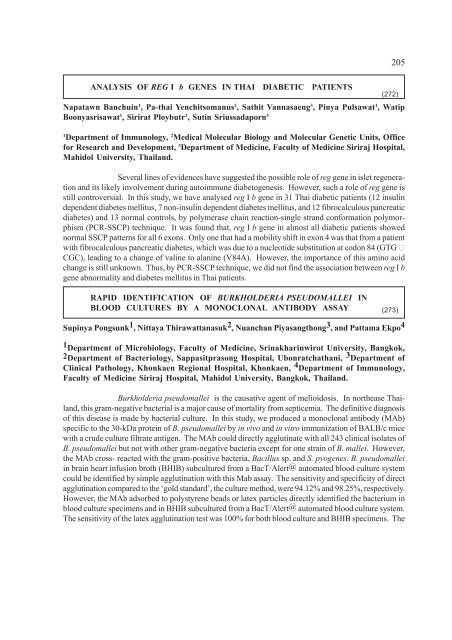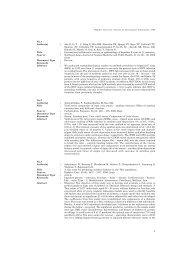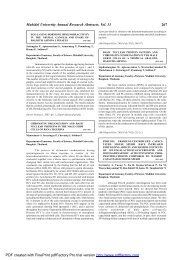THE OSTIA VENAE HEPATICAE AND THE RETHROHEPATIC ...
THE OSTIA VENAE HEPATICAE AND THE RETHROHEPATIC ...
THE OSTIA VENAE HEPATICAE AND THE RETHROHEPATIC ...
You also want an ePaper? Increase the reach of your titles
YUMPU automatically turns print PDFs into web optimized ePapers that Google loves.
ANALYSIS OF REG I b GENES IN THAI DIABETIC PATIENTS<br />
Napatawn Banchuin1 , Pa-thai Yenchitsomanus2 , Sathit Vannasaeng3 , Pinya Pulsawat1 , Watip<br />
Boonyasrisawat1 , Sirirat Ploybutr3 , Sutin Sriussadaporn3 (272)<br />
1 Department of Immunology, 2 Medical Molecular Biology and Molecular Genetic Units, Office<br />
for Research and Development, 3 Department of Medicine, Faculty of Medicine Siriraj Hospital,<br />
Mahidol University, Thailand.<br />
Several lines of evidences have suggested the possible role of reg gene in islet regeneration<br />
and its likely involvement during autoimmune diabetogenesis. However, such a role of reg gene is<br />
still controversial. In this study, we have analysed reg I b gene in 31 Thai diabetic patients (12 insulin<br />
dependent diabetes mellitus, 7 non-insulin dependent diabetes mellitus, and 12 fibrocalculous pancreatic<br />
diabetes) and 13 normal controls, by polymerase chain reaction-single strand conformation polymorphism<br />
(PCR-SSCP) technique. It was found that, reg I b gene in almost all diabetic patients showed<br />
normal SSCP patterns for all 6 exons. Only one that had a mobility shift in exon 4 was that from a patient<br />
with fibrocalculous pancreatic diabetes, which was due to a nucleotide substitution at codon 84 (GTG ³<br />
CGC), leading to a change of valine to alanine (V84A). However, the importance of this amino acid<br />
change is still unknown. Thus, by PCR-SSCP technique, we did not find the association between reg I b<br />
gene abnormality and diabetes mellitus in Thai patients.<br />
RAPID IDENTIFICATION OF BURKHOLDERIA PSEUDOMALLEI IN<br />
BLOOD CULTURES BY A MONOCLONAL ANTIBODY ASSAY<br />
Supinya Pongsunk1 , Nittaya Thirawattanasuk2 , Nuanchan Piyasangthong3 , and Pattama Ekpo4 (273)<br />
1 Department of Microbiology, Faculty of Medicine, Srinakharinwirot University, Bangkok,<br />
2Department of Bacteriology, Sappasitprasong Hospital, Ubonratchathani, 3 Department of<br />
Clinical Pathology, Khonkaen Regional Hospital, Khonkaen, 4 Department of Immunology,<br />
Faculty of Medicine Siriraj Hospital, Mahidol University, Bangkok, Thailand.<br />
Burkholderia pseudomallei is the causative agent of melioidosis. In northease Thailand,<br />
this gram-negative bacterial is a major cause of mortality from septicemia. The definitive diagnosis<br />
of this disease is made by bacterial culture. In this study, we produced a monoclonal antibody (MAb)<br />
specific to the 30-kDa protein of B. pseudomallei by in vivo and in vitro immunization of BALB/c mice<br />
with a crude culture filtrate antigen. The MAb could directly agglutinate with all 243 clinical isolates of<br />
B. pseudomallei but not with other gram-negative bacteria except for one strain of B. mallei. However,<br />
the MAb cross- reacted with the gram-positive bacteria, Bacillus sp. and S. pyogenes. B. pseudomallei<br />
in brain heart infusion broth (BHIB) subcultured from a BacT/Alert@ automated blood culture system<br />
could be identified by simple agglutination with this Mab assay. The sensitivity and specificity of direct<br />
agglutination compared to the ‘gold standard’, the culture method, were 94.12% and 98.25%, respectively.<br />
However, the MAb adsorbed to polystyrene beads or latex particles directly identified the bacterium in<br />
blood culture specimens and in BHIB subcultured from a BacT/Alert@ automated blood culture system.<br />
The sensitivity of the latex agglutination test was 100% for both blood culture and BHIB specimens. The<br />
205

















